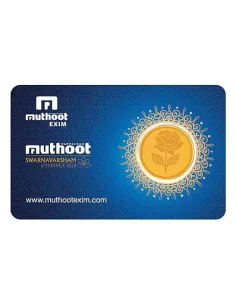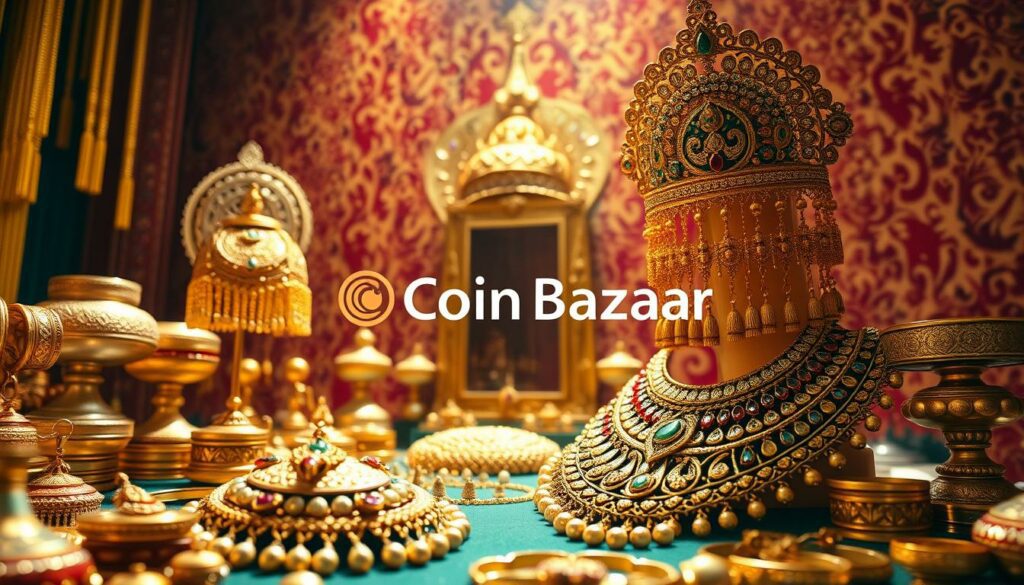Exclusive Deals & Trending Items


Muthoot Pappachan Swarnavarsham Gold Hallmarked Rose Coin of 5 gms in 22 KT 916 Purity Fineness
Shop NowGold has always been a sign of wealth and a reliable investment for many. It can be in the form of jewellery, coins, or other accessories. But which one gives the best returns over time?
In India, gold jewellery is not just a fashion statement but also a financial asset. However, gold coins have their own perks like being 24K pure, unlike jewellery which is 18K–22K. Both need care to keep their value, but they differ in manufacturing costs and how easy they are to sell.
This article explores how purity, hidden fees, and design choices affect long-term gains. It helps you understand which one might be better for your investment.
Key Takeaways
- Gold coins retain higher resale value due to 24K purity and lower processing costs.
- Gold jewellery’s intricate designs add beauty but increase wastage and breaking charges.
- Coin denominations start as low as 1g, making them more budget-friendly than large gold accessories.
- Purity verification through hallmarking is critical for both forms to avoid fraud.
- Cultural preference for gold jewellery in India often outweighs pure investment metrics.
Understanding Gold as an Investment Vehicle


Gold has been a key to wealth for thousands of years. It has been used by ancient empires and is still valued today. In India, gold is used in both gold jewelry and coins, offering unique investment opportunities.
Historical Significance of Gold in Investments
Gold was currency and jewelry in ancient times. Today, 49% of gold is used for fine jewelry. However, selling gold jewelry can be tricky because of high costs.
Gold jewelry is valuable culturally but often sells for less than raw gold. This is because of the high markup costs, sometimes up to 300%.
Why Gold Remains a Safe Haven
- Acts as insurance against inflation and currency devaluation
- Negative correlation with stock markets during crises
- Physical ownership offers tangible security
Gold prices rose 25% in 2008 and 40% in 2020. This shows its reliability. Central banks hold over 36,000 tonnes of gold as reserves.
Current Market Trends
| Factor | Gold Jewelry | Gold Coins |
|---|---|---|
| Liquidity | Slower due to craftsmanship costs | Quicker resale via standardized purity |
| Purity | Typically 22K–24K with alloy metals | 99.9% pure in coins like South Africa’s Krugerrand |
Investors prefer coins like the Krugerrand, with 46 million troy ounces in circulation. Gold jewelry demand falls when prices rise. But, cultural love for gold keeps it popular in India, where it makes up 70% of demand.
The Cultural Significance of Gold in India
Gold is more than a metal in India; it’s a big part of everyday life. For ages, gold jewellery has been a symbol of heritage and tradition. Think of a wedding without a mangalsutra or nose ring: it’s hard to imagine.
These pieces are not just family heirlooms. They tell stories of love, faith, and strength passed down through generations.


- Weddings: Gold jewellery is at the center of a bride’s dowry, with designs like maang tikka or jhumkas showing marital happiness.
- Religious rituals: Places like Tirumala Venkateswara get tons of gold donations every year, seen as gifts to gods.
- Inheritance: Families keep gold jewellery as both wealth and a sentimental treasure, making it valuable beyond its weight.
“Gold is the soul of Indian festivals and ceremonies.”
Even today, gold luxury accessories are key at Indian weddings and festivals. Modern trends may change, but the cultural appeal stays strong. Techniques like meenakari and kundan show centuries of craftsmanship, making these pieces timeless.
Whether at a temple visit or a family event, gold jewellery in India is more than an investment. It’s a living part of the culture.
Gold Jewellery: Beyond Aesthetic Appeal
Indian homes have 24,000 tons of gold, showing its deep cultural and financial value. Gold jewelry’s worth goes beyond its weight. It’s about the craftsmanship, design, and cultural meaning.
Every piece of designer jewelry has a story. Here are key factors that increase its value:
- Handcrafted techniques like filigree or meenakari
- Traditional motifs mixed with modern designs
- Certifications that prove its authenticity and purity
The Craftsmanship Value in Fine Jewelry
Skilled artisans spend weeks perfecting details in high-end jewelry. Methods like statement jewelry sculpting or gem-setting add value. A 2023 study by the World Gold Council showed that detailed pieces can keep 15-20% more value than simple gold bars.
| Factor | Craftsmanship Impact | Investment Impact |
|---|---|---|
| Design Originality | Unique patterns and styles | Higher resale demand |
| Brand Prestige | Signature house techniques | Collectible status |
| Material Innovation | Use of rare gemstones | Rarity drives premiums |
How Designer Jewelry Affects Investment Value
Brands like Croisset or Charmex are sought after for their reputation. A limited-edition designer jewelry collection might sell for 30% more than gold. Rare items, like Cartier’s Tutti Frutti motifs, can double in value over a decade.
Statement Jewelry as Both Fashion and Investment
Statement jewelry combines bold looks with lasting value. Pieces like big diamond necklaces or geometric bangles often keep 80-90% of their original price. Choose timeless designs from well-known brands to balance style with investment.
Understanding the True Cost of Gold Jewellery
Buying gold jewellery is more than just the metal’s price. There are hidden fees and taxes that increase the cost. Let’s break down what you’ll pay:
Making Sense of Making Charges
Making charges differ based on the retailer and design. They cover the craftsmanship, design, and labor. For instance, a 15.76g 22KT bangle costs ₹70,000/10g:
- Base gold cost: ₹1,10,320
- Making charge (15%): ₹16,548
These charges can be per gram or a percentage of the gold cost. Always ask how they calculate these fees.
Wastage Fees: What You Pay for Lost Metal
Wastage fees cover gold lost during shaping. Retailers add 5-10% for this. For a 12g bracelet:
| Cost Type | Calculation | Total |
|---|---|---|
| Gold (12g x ₹7,000) | ₹84,000 | |
| Making charge (15%) | ₹12,600 | |
| Wastage (5% of gold cost) | ₹4,200 |
Wastage is a necessary part of making. Look for clear pricing to avoid surprises.
Taxes and Hidden Costs
India’s 3% GST is added to the total cost, including making charges. Hallmarking fees (₹45 per piece) ensure purity but increase the price. Here’s an example:
“Hallmarking ensures your gold jewellery meets BIS standards, but check if retailers include this cost upfront.”
The final price includes the gold price, making charges, 3% GST, and hallmarking. Avoid brands that hide these costs until checkout.
Remember, luxury accessories like gemstone-studded pieces have extra costs for stones and designs. Always compare prices to get the best deal!
Gold Coins: The Investor’s Perspective
Gold coins are a smart choice for investors over gold accessories or fine jewelry. They are made of 24K or 22K gold, meeting international standards. Their value is based on gold’s current price, unlike gold accessories, which can lose 15-35% of their worth due to design costs.
For example, Sovereign Gold Bonds or India’s 24K Ashoka coins have 99.9% purity. This means they have very little markup.
- No crafting costs: Coins don’t have the making charges that fine jewelry does. This means you keep more of your money.
- Tax efficiency: In India, selling gold coins doesn’t incur Capital Gains Tax. But, gold accessories might face 18-28% taxes on resale gains.
- Liquidity edge: Coins are easier to turn into cash than gold accessories. This is because they don’t have to account for design and craftsmanship costs when resold.
Coins like the American Eagle or India’s Good Delivery bars come with certification. This ensures they are genuine. Their uniformity makes them easier to trade worldwide. On the other hand, gold accessories can lose value due to changing fashion trends. For instance, a vintage necklace might lose 50% of its value if styles change, while a 1-ounce gold coin’s value stays tied to market rates.
“Coins are liquid assets that don’t care about gemstones or engravings,” says a Mumbai-based financial advisor. “They’re pure gold with no markup drama.”
Investors like coins for their clear value and tax benefits. While fine jewelry may dazzle, its resale value often drops below 60% of what you paid. Coins, however, keep 98-99% of their value. For a hands-on approach, owning physical coins means no middlemen markup. Consider pairing this with ETFs for diversification, but always choose tax-free options like Sovereign Gold Bonds.
Purity Matters: Comparing Gold Standards
When you buy gold jewelry, its purity is key. More purity means more gold, but it also affects how it’s used. Let’s look at the numbers and certifications that guide your choices.
24K vs 22K: Which is Better for Investment?
24K gold is almost pure (99.9%) but very soft. It’s rare in designer jewelry. On the other hand, 22K (91.7% pure) is more common because it’s durable.
Coins usually have 24K gold for its high purity. But, 22K is better for gold jewelry because it’s less likely to scratch.
- 24K: 99.9% pure, soft, ideal for coins
- 22K: 91.7% pure, durable for everyday gold jewelry
- 18K: 75% pure, popular in high-end designer jewelry for its luster
Understanding Hallmarking and Certification
Always look for BIS hallmarks to ensure authenticity. Legit gold jewelry has three marks: the BIS logo, fineness (like 916 for 22K), and the seller’s mark. Unmarked items can lose value.
Hallmarked gold holds 10-15% higher resale value than non-certified pieces.
Be careful of banned alloys like KDM gold (gold-cadmium mixes). They’re not certified and can be harmful. When buying designer jewelry, make sure it’s marked.
Pure gold (18K-22K) is also better for sensitive skin because it has less alloy. Look for purity marks like ‘375’ (9K), ‘585’ (14K), or ‘750’ (18K) to confirm quality. Purity is not just a number; it protects against fakes and increases value over time.
Liquidity Comparison: Selling Gold Jewellery vs. Gold Coins
Not all gold is created equal when it comes to selling. Let’s look at how high-end jewelry and coins compare for quick cash.
Challenges in Reselling Luxury Accessories
Reselling luxury accessories like high-end jewelry can be tough. Here’s why:
- Design trends: Unique styles may not appeal to all buyers.
- Maker charges: These aren’t refundable when selling. For example, a ₹50,000 piece might lose 15–25% just from these costs.
- Subjective beauty: A piece’s value depends on someone else liking its craftsmanship.
| Factor | High-End Jewelry | Gold Coins |
|---|---|---|
| Resale Value | 20-30% lower than purchase price | 2-5% lower due to market fluctuations |
| Evaluation Process | Requires assessing design and purity | Quick verification via hallmark |
| Sales Channels | Limited to jewellers or auctions | Available at banks, exchanges, and online platforms |
The Ease of Trading Gold Coins
Gold coins are simpler to deal with. They have a standard purity (99.9%) and weight, making prices clear. For example, a ₹10,000 gold coin can sell for 95-98% of its melt value at banks. Digital platforms like Zerodha or CaratLane let you trade coins instantly with real-time rates.
Coins keep more value because their worth is just about gold content—not design. This makes them perfect for quick sales with little loss.
Storage and Insurance Considerations
Keeping gold accessories and fine jewelry safe is key to preserving their value. First, pick a secure spot. Home safes are a good choice but need strong locks. Bank lockers are secure but cost money. For the most valuable items, like family heirlooms, professional vaults are the best option.
| Option | Pros | Cons |
|---|---|---|
| Home Safe | Convenient access | Potential burglary risk |
| Bank Locker | Monitored security | Fixed visiting hours |
| Professional Vault | 24/7 surveillance | Highest cost |
Insure your valuables to protect your investment. Look for policies that cover theft, fire, and natural disasters. In India, many insurers offer special gold accessories coverage. Make sure to include “mysterious disappearance” clauses. Keep records: take photos, store appraisals, and update policies yearly. When traveling, use hidden packaging and safe transport.
- Opt for insurance with 24k gold purity coverage
- Review excess amounts to avoid unexpected claim gaps
- Verify if policies cover fine jewelry repairs after accidents
Proper storage and insurance can turn risks into manageable safeguards for your precious metal investments.
Depreciation Factors: What Causes Value Loss
Investing in gold means knowing what makes its value go down. Physical wear and market changes are the big culprits. Here’s how to keep an eye on them.
Scratches, loose gemstones, or bent settings can cut a piece’s resale value by up to 30%. Even designer jewelry with fine details can lose value if not handled right. High-end jewelry with gems like diamonds or sapphires usually holds its value better than trendy items.
“Gold jewellery often contains impurities like silver, copper, or zinc, which lower its value when melted.”
- Store pieces in soft cloth pouches to prevent scratches
- Have gemstones checked yearly for looseness
- Avoid exposing jewelry to perfumes or chlorine
Global events like inflation or stock market drops can push gold prices up or down. Designer jewelry faces extra risks when fashion trends change. For example, bold 2023 styles might look dated by 2025, cutting resale value. Coins stay stable since their value depends on gold purity, not looks.
Brands matter too. A Cartier necklace might keep 80% of its value while a generic piece drops to 50%. Always check hallmark certificates to track purity levels changes.
Tax Implications for Different Gold Investments in India
Understanding tax rules for gold investments can be tough. Whether you’re buying gold jewellery or trendy pieces, knowing tax impacts is crucial. Here’s what you need to know:
Long-term Capital Gains on Gold
- Gold held for over 36 months gets long-term capital gains (LTCG) taxed at 20.8% with indexation benefits.
- Short-term gains (
- Inherited gold’s holding period starts from the date of inheritance.
GST and Other Applicable Taxes
- Gold jewellery: making charges have 5% GST; raw gold gets 3% GST.
- Imported gold bars face 10% customs duty plus GST.
- Gifted gold over ₹50,000 may trigger taxes unless from a close relative.
Smart planning can lower your taxes. For example, holding gold jewellery over 36 months can help with indexation benefits. Always report holdings within legal limits (e.g., 500g for married women) to avoid wealth tax risks. Talk to a tax advisor to make your gold investments work for your financial goals.
Digital Gold: The Modern Alternative
Investing in gold doesn’t mean you have to buy gold accessories or statement jewelry. Digital gold is a smart way to own gold without the need for physical storage. You can buy fractions of gold through ETFs, Sovereign Gold Bonds, and digital accounts. These options let you invest at prices that match the real-time market.
- Start small: Invest as little as ₹100, ideal for those new to gold investing.
- No storage costs: Your gold is kept in secure vaults, insured and audited regularly.
- Track instantly: Check prices and sell anytime via apps or online platforms.
- No wastage fees or markup: Avoid the extra costs tied to gold accessories or jewelry craftsmanship.
Unlike physical statement jewelry or bars, digital gold doesn’t take up space or require security. It’s regulated by SEBI, making it safer from fraud. However, you can’t physically hold your investment, and there’s a risk of cyber threats. For those who value convenience over physical assets, digital gold is a big leap forward. It can be part of your portfolio, alongside physical gold, depending on your investment goals.
Creating a Balanced Portfolio with Different Gold Assets
Building a gold portfolio is not just about coins or jewelry. It’s about mixing both for growth and personal enjoyment. Trendsetting jewelry and statement pieces add a unique touch to your collection. Let’s see how to blend them wisely.
At times, jewelry offers more than just its metal value. Trendsetting pieces from designers like Cartier or Tanishq can increase in value due to their craftsmanship and demand. Statement jewelry, such as engraved necklaces or avant-garde earrings, not only have resale value but also make a fashion statement. These items also serve as family heirlooms, merging emotional value with investment.
Align your choices with your investment goals. For those looking for long-term growth, consider allocating 50% to ETFs (starting at ₹5,000) and 30% to coins. Add 20% in statement jewelry from top brands for diversification. For instance, a ₹50,000 portfolio could include ₹10,000 in Cartier’s new trendsetting collection. Retirees might prefer 70% digital gold (starting at ₹1) + 30% classic jewelry for easy access and cultural significance.
“By diversifying investments into different forms of gold, you can reduce overall portfolio risk and potentially enhance returns.”
Consider the costs: Jewelry’s making charges (like 10-20% of total cost) versus coins’ lower fees. Pairing gold ETFs with heirloom-style statement jewelry creates a balanced mix. Remember, gold should make up 5-10% of your total assets.
Conclusion: Making the Right Gold Investment for Your Future
Choosing between gold jewelry and coins depends on your goals. Gold jewelry is loved for its cultural value and beauty. However, it costs more because of the craftsmanship.
Coins, on the other hand, are known for their pure metal and standard designs. They often keep their value better over time. Think about what’s more important to you: tradition or making money.
Storage and how easy it is to sell also matter. Coins are simpler to store and trade. But gold jewelry’s design can make selling it harder. If family history is key, jewelry’s emotional value might be worth the resale challenges.
For those looking for growth, coins are a clearer choice. They offer better long-term gains, even if they don’t hold as much sentimental value.
In India, you can also consider Sovereign Gold Bonds or ETFs. But many still choose physical gold. Some mix coins for growth and jewelry for luxury. Your choice should match your goals: pure metal value or family treasures.
Consider what you need: a market winner or a piece for your home? Look up current prices and talk to experts. Gold’s timeless beauty means there’s no wrong choice—just the one that fits your future vision.



















